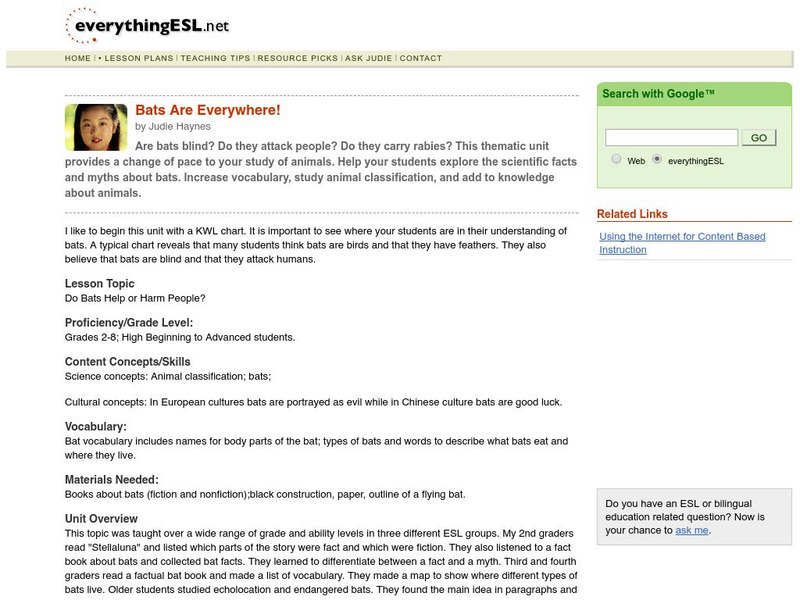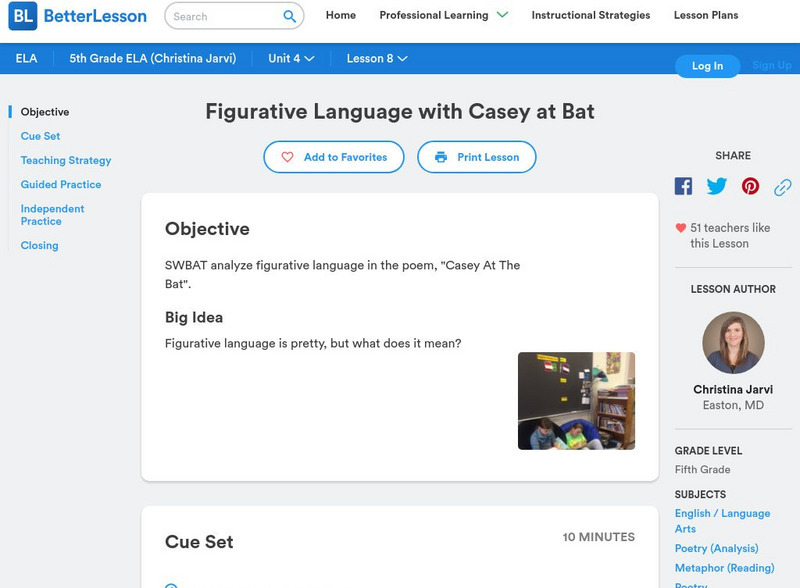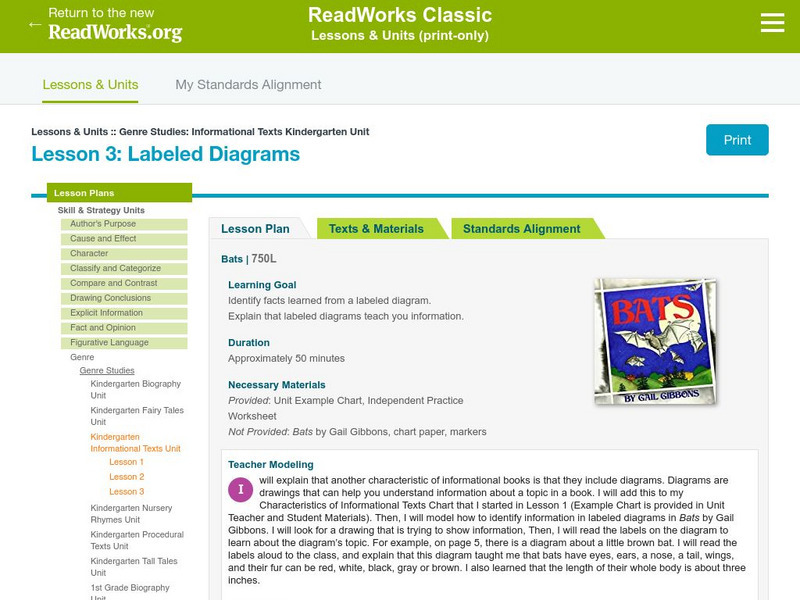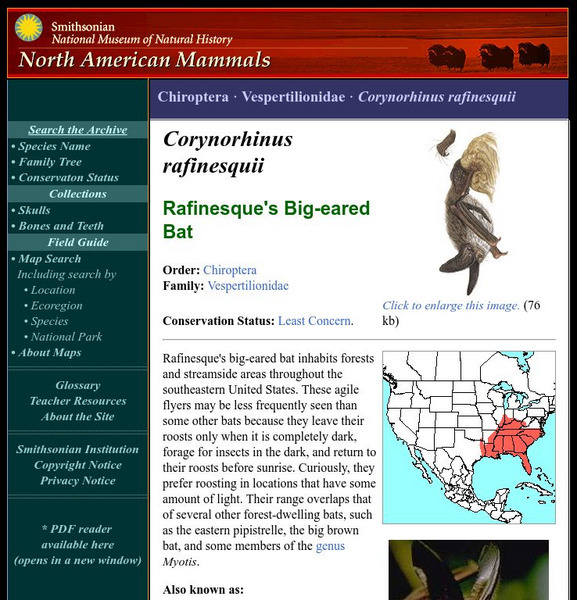Alabama Learning Exchange
Alex: What Is Your "Bat"itude?
This activity is for use at the beginning of a unit on bats to help determine students' previous knowledge about bats as well as their bat attitudes. Students will begin by drawing an illustration describing their feelings about bats....
Alabama Learning Exchange
Alex: 'Batty' About Bats!! (Writing)
As a part of a week-long unit about bats, the students will identify the characteristics of a bat and write an essay about bats. Student understanding will be enhanced through the use of books, poems, lectures, discussions, individual...
Everything ESL
Bats Are Everywhere!
"Bats are Everywhere" is a thematic unit which will help students explore the facts and myths about bats.
Everything ESL
Bats Are Everywhere!
"Bats are Everywhere" is a thematic unit which will help students explore the facts and myths about bats.
Alabama Learning Exchange
Alex: "Batty" About Bats!! (Reading)
As a part of a week-long unit about bats, the students will identify the characteristics of a bat and organize the facts using Think-sheets. Student understanding will be enhanced with the use of books, poems, lectures, discussions,...
Scholastic
Scholastic: Online Theme Unit for Caves
Discover more about caves through this online interactive theme unit. This resource provides links to sea caves, cave animals, caves in the United States, the science of caves and more.
Unite for Literacy
Unite for Literacy: Mystic Aquarium: Bats Dare to Be Different
Read about bats' characteristics, habitat, diet, behavior, and their unique hearing ability called echolocation. You'll also learn why they are important to humans, the threats they face, and what you can do to help them. Includes audio...
Better Lesson
Better Lesson: Unit: Figurative Language With Casey at Bat
In this lesson, 5th graders learn how to analyze figurative language in the poem, "Casey At The Bat."
American-Israeli Cooperative Enterprise
Jewish Virtual Library: The First American Bat Mitzvah
Enlightening story of the first Bat Mitzvah to take place in America in 1922.
PBS
Nh Pbs: Nature Works: Red Bat
The red bat can be found in forests from southern Canada through the United States and down to Chile and Argentina. The content of this site includes a look at this species' characteristics, range, habitat, diet, life cycle, and behavior.
Read Works
Read Works: Genre Studies: Informational Text Kindergarten Unit: Labeled Diagrams
[Free Registration/Login Required] Lesson uses Bats by Gail Gibbons to teach students how to identify facts learned from labeled diagrams within an informational text. Ideas for direct teaching, guided practice, and independent practice...
Smithsonian Institution
National Museum of Natural History: American Mammals: Eastern Red Bat
Common and widespread from far southern Canada throughout most of the United States and Mexico, and farther south through Central America and into South America, the Eastern Red Bat requires trees and shrubs for roosting. It is...
Smithsonian Institution
National Museum of Natural History: American Mammals: Rafinesque's Big Eared Bat
Rafinesque's big-eared bat inhabits forests and streamside areas throughout the southeastern United States. These agile flyers may be less frequently seen than some other bats because they leave their roosts only when it is completely...
Smithsonian Institution
National Museum of Natural History: American Mammals: Pallid Bat
Common throughout its range, the pallid bat occurs in arid and semi-arid regions throughout northern Mexico and the western United States. Pallid bats eat beetles, grasshoppers, and moths, and they forage for slow-moving prey, such as...
Smithsonian Institution
National Museum of Natural History: American Mammals: Brazilian Free Tailed Bat
Millions of Brazilian free-tailed bats spend their summers in the southwestern United States. Gigantic colonies summer in Bracken Cave, Texas; Carlsbad Caverns, New Mexico; and even within the city of Austin, Texas, under the Congress...
Smithsonian Institution
National Museum of Natural History: American Mammals: Mexican Long Tongued Bat
Mexican long-tongued bats feed on fruits, pollen, nectar, and probably insects. The populations that summer in the United States migrate to Mexico and northern Central America in winter, following the blooming cycle of plants such as...
Smithsonian Institution
National Museum of Natural History: American Mammals: Southwestern Myotis
Southwestern myotis live in a variety of southwestern mountain habitats, from desert grasslands up into pine and mixed coniferous forest in the United States, and in desert and grassland in Mexico. These bats and two other myotis...
PE Central
Pe Central: Toss and Hit (Striking)
Through this activity, students work in pairs and practice striking balls of various sizes with different types of bats. A great lesson to precede a gym unit on baseball, "Striking - Toss and Hit" can be modified for use in elementary...
Smithsonian Institution
National Museum of Natural History: American Mammals: Western Small Footed Myotis
The western small-footed myotis occurs in limited areas of southwestern Canada, throughout much of the western United States, and into Mexico. It is better adapted to moist areas than to dry ones. Learn more about the Myotis ciliolabrum,...


















